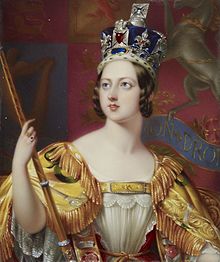BY JAMES GREGORY

A beautiful young queen is moved to commute the sentence on those condemned to be executed for high treason – with all the horrors of hanging, drawing and quartering – aided by the advice of her dashing prime minister. Viewers of the most recent, third, episode of ITV’s series, Victoria (which aired 4 September 2016), were presented here, at least, with something that echoed a Victorian reality, if not the facts of the Queen’s relationship to the reprieve of the leaders of the Chartist rising at Newport in South Wales in 1839.
While Daisy Goodwin’s script goes for drama over historic accuracy (in the plotline involving the queen’s response to her dresser, whose nephew is one of the condemned men), the treatment of the Chartist rising in the ‘Brocket Hall’ episode does raise the question about what role the queen actually played in the exercise of mercy after rebellions across her empire? And what did her contemporaries think her private feelings and actions were?
My research is interested in the mythmaking and rumour concerning such acts of royal mercy. For just as Queen Victoria enjoyed a makeover as the photogenic Jenna Coleman in the 2016 series, the real Queen of the late 1830s came to be presented in hagiography and iconography as the naïve but kind-hearted girl – succeeding to a crown tarnished by the misbehaviour of her uncles – who insisted on showing mercy towards those condemned to death.
These stories circulated in press accounts and popular histories of the reign at the time of her 1887 and 1897 jubilees, and at her death. See, for example, ‘The Queen and the Deserter’s Death Warrant,’ an illustration by Baines from Robert Wilson’s The Life and Times of Queen Victoria (published in 1893) and George Alfred Henty’s Queen Victoria: scenes from her life and reign (published in 1901) which also included an illustration of ‘The first death warrant’.
These reflect popular conceptions from the start of her long reign that the queen was obliged to sign death warrants; or that appeals to the queen in person, might force her Home Secretary to grant a stay of execution.
This idea of the royal exercise of mercy was politicised from the beginning of the Victorian era, with newspaper tales of royal ignorance or clemency shaped by Tory, Whig and radical prejudices.
Goodwin’s script for the new series, has focused in the early episodes in part on the relationship between the new queen and her Whig prime minister, played by the suave Rufus Sewell. And certainly Melbourne was discussed in relation to royal mercy, by the contemporary press. In the ‘Chit-Chat’ section to The Satirist, in 26 November 1837, for example, there appeared the following scene:
‘How do they hang men?’ asked the all gracious Queen of her royal mother, after executing the death warrant of the Scotch criminal. ‘With a rope, my dear,’ replied the Duchess. ‘A rope!’ exclaimed the maiden sovereign, ‘do you mean a skipping-rope?’ Lord Melbourne, who was present, as in duty bound, explained the mystery of criminal strangulation.
Here, Melbourne is presented in the guise of the wise paternal figure: the reality according to biographers of Melbourne was that he thought Victoria would not hesitate to sign a death warrant if she thought the culprit deserved to be executed.
The press had a powerful role to play. The London paper John Bull, which was rabidly anti-Whig, noticed a news item which had been published in various newspapers in July and August 1837:
On the first warrant for execution being presented to the QUEEN to sign, she burst into tears. Lord MELBOURNE said, ‘Your Majesty knows you have the prerogative of mercy.’ ‘Then’, she replied, ‘let the sentence be changed to transportation for life.’
John Bull corrected this basic error about the sovereign’s role, for ‘everybody who happens to know anything’ knew this was not so – in the past it had only been in London that the monarch was directly involved in the exercise of the death penalty, it reminded its readers, when the king merely said to the Home Secretary let the law take its course. The bill removing this role had been introduced ‘for some unknown reason’, and thus ‘a privilege taken away from the wretched culprits, who always looked up most justly and reasonably to the Royal mercy, or at least the royal investigation, of which the present Liberal Ministers have deprived them.’ The ‘poor young Queen’ by Whig coup had been deprived of what was ‘considered one of the blessed prerogatives of her station’.
Despite the scorn of a newspaper such as John Bull, the episode concerning the queen’s tearful appeal to her prime minister over the fate of a military deserter (in some versions, the figure advising her, is the Duke of Wellington), had a surprising durability as an episode in her popular biography, often with the title ‘Think again, I pray you!’ taken from the admonition the monarch was supposed to have uttered to the statesman, before she gives her signature to the reprieve.
Chartists did appeal to the young Queen to exercise her royal influence to save the Newport Chartists from a barbarous execution, and as the campaign continued into the 1840s to release them from their Australian exile. The Chartist Executive Committee, addressing the members of the National Charter Association, explained its strategy in January 1846 thus (as reported in the main Chartist paper):
According to the authority politically phrased our glorious Constitution! the Queen is the fountain of mercy. She alone has the power of annulling or commuting a sentence pronounced by judicial authority. Hence, then, our course is clear; to snap the chains of captive patriots, we must work upon the royal sympathy; we must strive by every available means to direct the current of royal clemency to Frost, Williams, and Jones, that it may refresh them with liberty and happiness.
Northern Star, 17 January 1846
Relatives of condemned infanticides and murderers would also continue to appeal to the Queen throughout her reign. Newspaper readers were told in 1886:
It has long been understood to be the personal desire of Queen Victoria that her reign should be signalised by the abolition of the hangman.
‘The Gallows and the Jubilee!’ Northern Echo, 18 November 1886
The Empire too, when presented as a force for mercy in the world, was linked to the figure of the merciful Queen in discourse around the abolition of slavery or (ironically) in the aftermath of the rebellion in India in 1857. The Baptist Magazine had stated:
Millions, still half-enslaved, and bitterly oppressed, are seeking now for succour, and relief, from her benignant clemency. Every sophism that can be used, by sinners trained to cruelty, and bloated with the fruit their oppression, will be employed to dry up all the deep fountains of her compassion
Baptist Magazine, September 1837, p.400
Scholars have explored the exercise of mercy by monarch and elites in the modern and early modern period – looking at mercy in the Tudor period, for example in studies such as Mary Villeponteaux’s The Queen’s Mercy. Gender and Judgment in Representations and K.J. Kestelring’s Mercy and Authority in the Tudor State.
Mercy as the brightest jewel in the royal diadem remained a cliché of eulogy directed at Hanoverian royalty in poetry, funeral sermons and obituaries. I am interested in Victoria’s presentation in newspaper editorials, correspondence, and cartoons, such as those in the satirical Judy (commenting on the efforts to reprieve Fenian terrorists in 1867): wielding or staying the sword of justice.
As part of my project on the cultural history of mercy, I’ve also studied the representation of mercy in painting and statuary – in royal courts of justice, in the rebuilt houses of parliament, and in historical painting. The depiction of mercy extends beyond monarchy and, in the period I study, it was fundamentally associated with a theology of divine judgement and the question, ‘when should the magistrate wield the sword of justice or mercy?’. However, in the Victorian era, it is also expressed in such concerns as animal welfare, with the establishment of ‘Bands of Mercy’ – which also enjoyed royal approval (through the patronage of the RSPCA) – in Britain to teach children kindness to animals .
Dr James R.T.E. Gregory is Programme Leader for the MA & ResM in History, and Lecturer in British History since 1800 at Plymouth University. He is the author of The Poetry and the Politics: Radical Reform in Victorian England (2014) and Victorians Against the Gallows: Capital Punishment and the Abolitionist Movement in Nineteenth Century Britain (2011).

